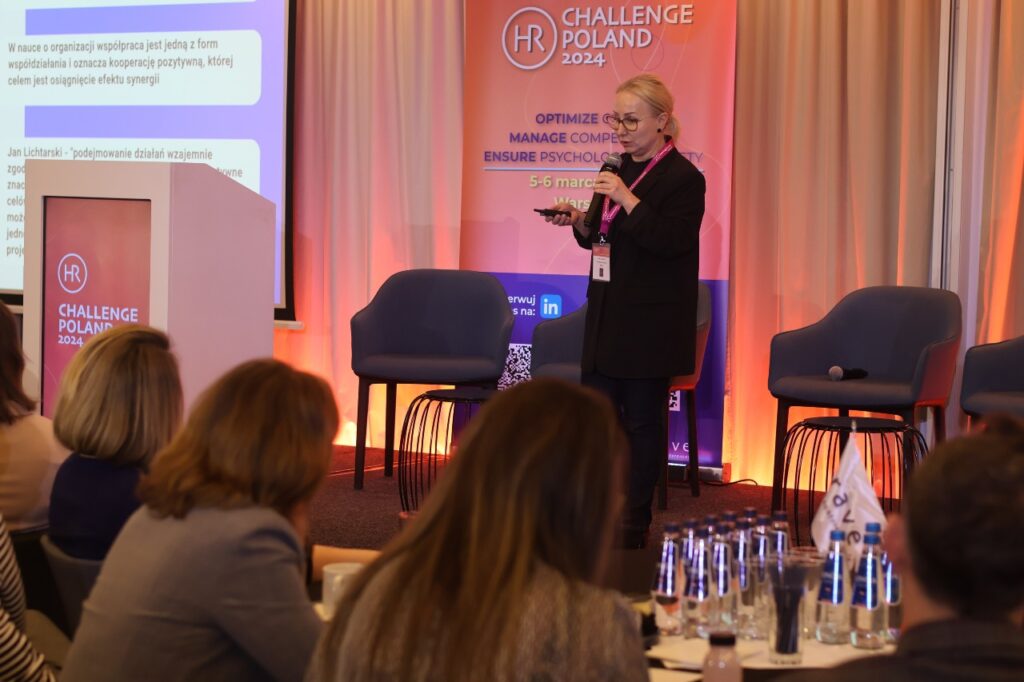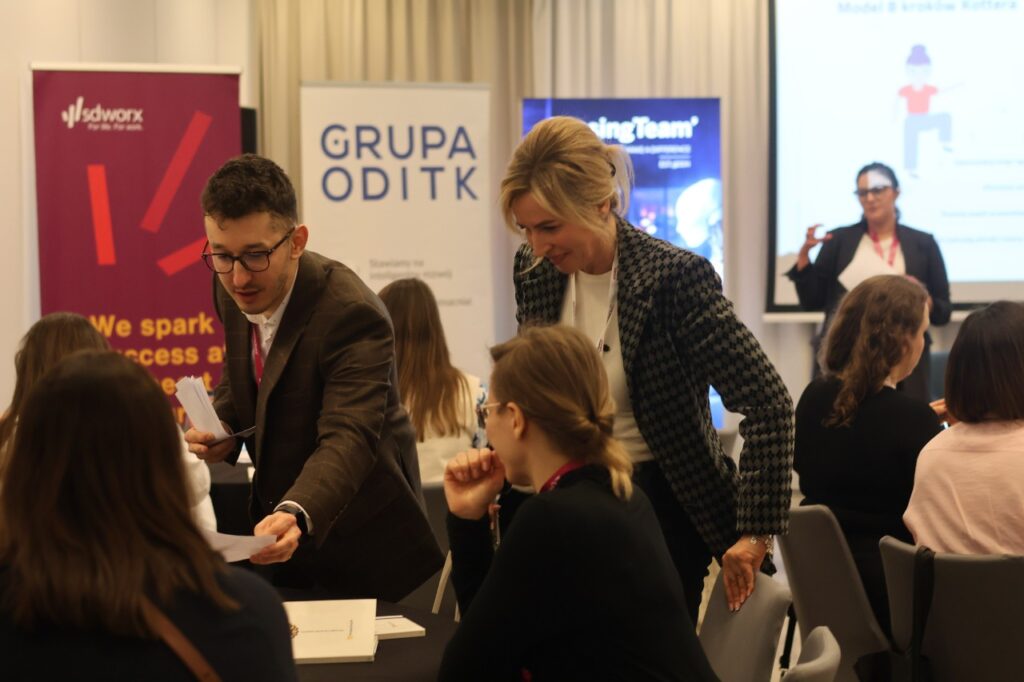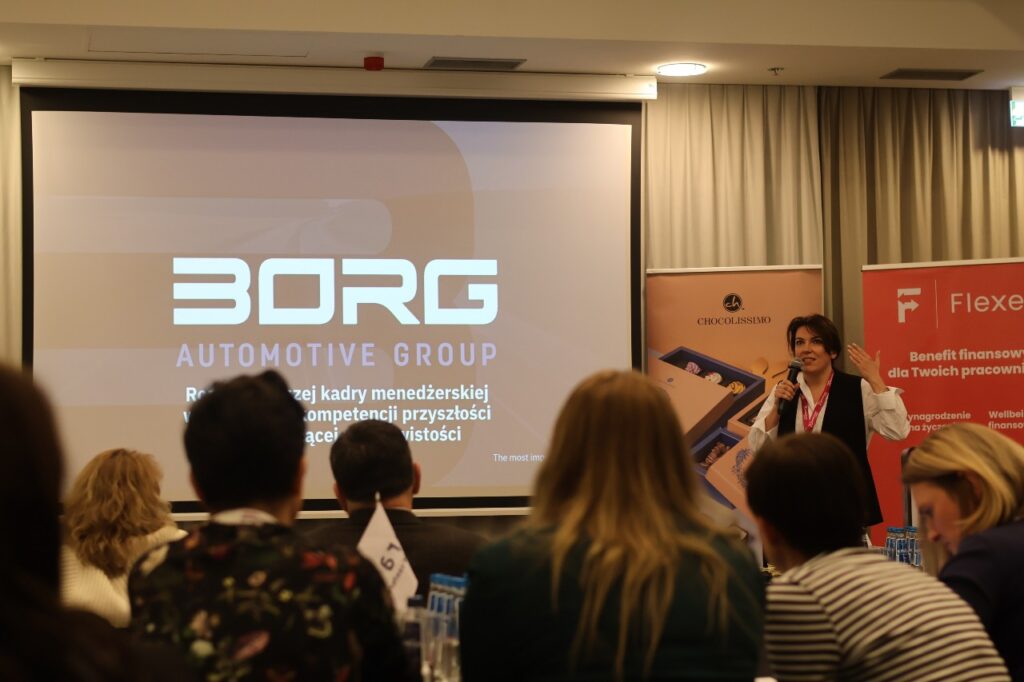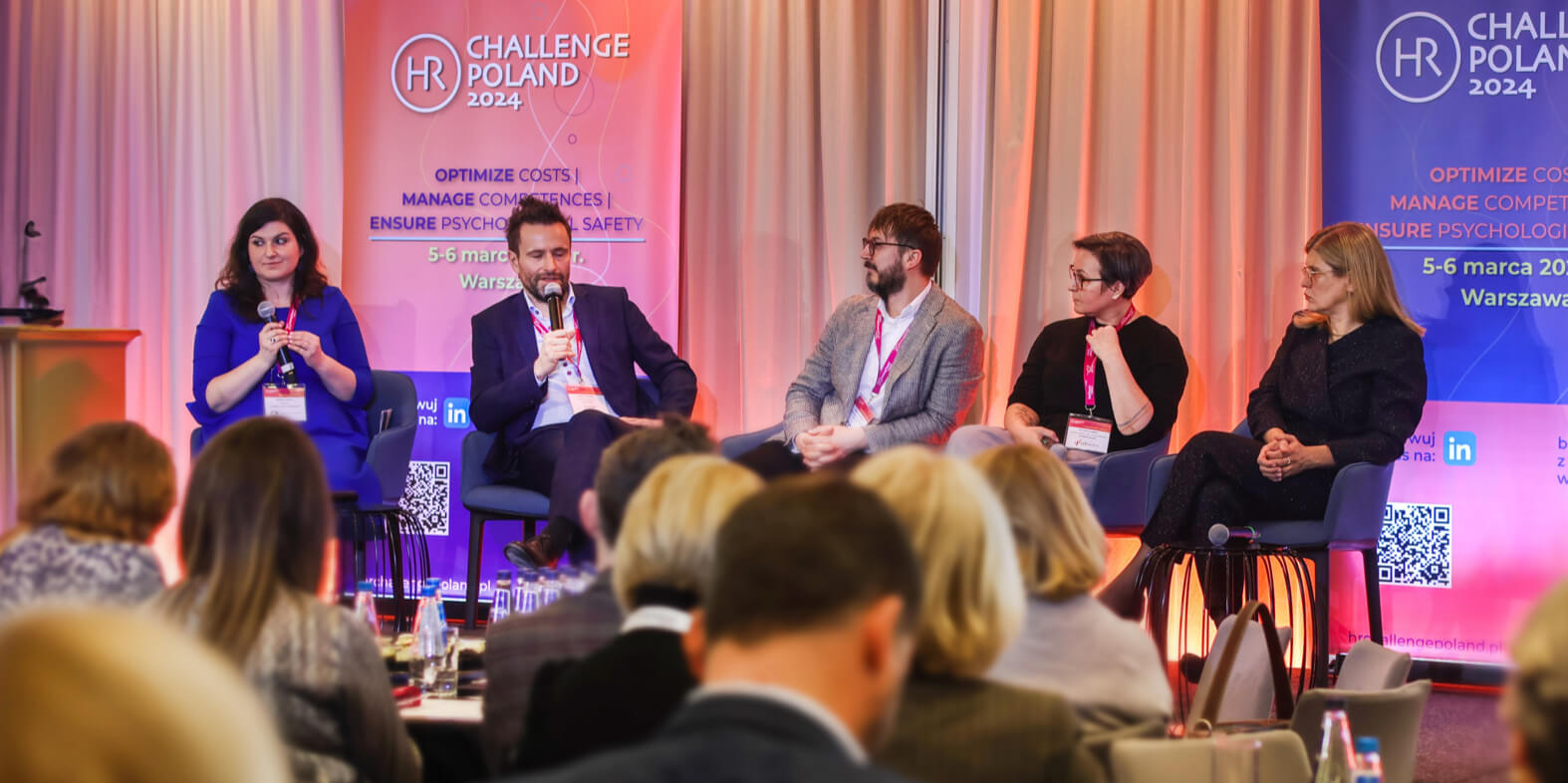Like in previous years, HR Challenge Poland gathered many HR enthusiasts from various industries. During a two-day event full of expert lecturers, guests had an incredible opportunity to explore the latest trends in human resources management and learn the best practices from leading HR experts from international companies.
Table of contents
- Increasingly modern HR
- Cross-departmental partnerships
- Remote work and candidate shortage
- HR as a change leader
- Diversity and inclusion are more than a theory
- Remote employee engagement
- Inflation and wage pressures
- Future leadership competencies
- The CEO-HR Partnership
- Psychologically safe workplace
- HR Challenge Poland – it’s worth being there!
HR has changed dramatically in recent years. These changes affect all of us – employees, HR professionals, and business owners. The work environment aspects such as remote work, employee engagement, and growing financial expectations have come to the fore. HR departments have faced a major challenge to find the balance between employee needs and opportunities while maintaining operational efficiency. These issues were discussed at this year’s edition of the HR Challenge Poland.
Increasingly modern HR
How will the labor market change in the next 3 years? Marcin Baranski (VOX Capital Group) addressed this question, stressing that traditional HR forecasting methods are inadequate and insufficient in the face of intense labor market changes. Thus, predicting the consequences of those changes is extremely difficult, or even impossible.
Therefore, HR departments must stay on top of things. This, however, requires them to constantly monitor the company’s situation and flexibly respond to any changes in the business environment. A huge challenge for companies is to adapt to organizational changes such as introducing remote work, hybrid work, or workation, which increases company attractiveness in the eyes of potential candidates. In turn, HR professionals are worried about being replaced by artificial intelligence. Still, it is more probable that rather than being replaced, employees will have to learn to work with new AI-based IT tools
Adaptation to changes in the labor market and appropriate HR strategies were also broadly discussed during the event. An opening lecture started with Gen Z and the phenomenon of “cyberloafing” i.e. the use of the Internet during working hours for personal purposes unrelated to professional duties. Marcel Kedzierski (CCC) confidently admitted that this phenomenon can be transformed to the benefit of the organization, for example, through the implementation of microteaching (microlearning) carried out via smartphones (you can read more about the potential of mobile applications in HR in this article – note Productive24).
The key point of the debate was a case of organizational structure and employee autonomy. Maciej Herman (Lotte Wedel) admitted that while the concept of a turquoise company may not be fully applicable for large enterprises such as Wedel, individual teams however can be given much more freedom if it comes to ex. the choice of values or working methods. This proves a noticeable switch in leadership style toward greater flexibility. As Agata Kaczmarska (Dentsu) stated, leaders should show more empathy towards employees in understanding their emotional states and using clear and appropriate communication. Such an approach not only has a positive impact on employee well-being but also improves the quality of leadership.
Cross-departmental partnerships
Although at first glance it seems that HR and finance departments operate independently of each other, this is certainly not true. In her presentation, Marta Foltyn (Mieszko) provided an accurate picture of what effective cooperation between these departments can look like and what are the effects of this synergy. Based on her own experience, she pointed out that the HR department plays a key role in finance when:
- it responds on time
- it provides the necessary financial information to support business objectives,
- there is a need to break down departmental barriers (i.e., breaking down silos).

What are the benefits of collaboration between finance and HR departments? The Finance Department provides controlling tools that support the process of employment planning and HR life cycle management. Moreover, by working in partnership, both departments at Mieszko have a complete “picture” of employees and their remuneration in the context of the company’s sales and production results. The company can plan production more effectively by having access to the information on demand for certain products from each category and knowing the number of available employees and current absences. If necessary, the HR department can act as quickly as possible. They can for example contact a temporary employment agency to overcome understaffing. The HR department therefore actively supports the implementation of Mieszko’s production plan.
Remote work and candidate shortage
Most companies have already adapted their structures to the remote work model, letting employees work from home. As Lidia Świderska (Miele) emphasized during the panel discussion, candidates are increasingly interested in workation. However, only 13% of companies in Poland provide such an option and have appropriate procedures in place for this purpose. In the case of the hybrid model, the situation looks much more favorable.
Marcin Drzewiecki (Iron Mountain Poland) noted that industries such as insurance, health care, and energy have adapted to it perfectly. This adaptation was much more difficult in the public sector and manufacturing. In turn, Inez Kulpinskaya (Topex Group) noted some positive aspects of hybrid work, including flexibility in managing breaks from work or adjusting office attendance to employees’ schedules. This approach has allowed Topex Group to expand its hiring reach and acquire candidates from various locations. Lidia Ołowska reminded us that the transition to remote or hybrid work is associated with organizational changes and a change in the role of managers. Therefore, a good leader must understand the needs of both the onsite and remote employees and adapt accordingly.
HR as a change leader
During HR Challenge Poland, guests could participate in one of four workshops. One of them was conducted by Monika Świderska and Paweł Więsek from Productive24. They focused on the role of HR departments in the digital transformation. During workshops, important steps to take before, during, and after the implementation of new IT tools were discussed. It was an excellent opportunity to gain the competencies necessary to conduct a business analysis, process mapping, and key resource planning for HR digitization projects. Participants were given a practical assignment where they needed to determine the necessary actions to manage the challenges that often arise during the implementation of new technology, including resistance from various stakeholders.

Diversity and inclusion are more than a theory
In the second part of the event, as usual, three thematic sessions referred to the current HR challenges. They’ve addressed the following questions:
- How to effectively reach candidates and create an attractive job offer?
- How to improve employee motivation and commitment?
- How to carry out salary negotiations?
Iwona Chrostowska (Primark), Łukasz Sowinski (Agora), Mania Kostrzewska (Dentsu) and Marta Fortuna (CD Projekt RED) referred to the challenges associated with diversity and inclusivity. Guests noted that although those challenges are often treated without due care and attention, and many companies find it difficult to translate this philosophy into concrete actions, more and more organizations see the potential in this area to create a more open and innovative work environment.
Mania Kostrzewska pointed out, that diversity organizes many aspects of the business, and a diverse team creates products that respond to different social groups. The authenticity of this diversity must be visible at all levels of the organization. However, as Lukasz Sowinski noted, the first step is to diagnose the current state. Such an analysis allowed Primark to look at diversity not only from a commercial perspective but also from an organizational context.
Iwona Chrostowska explained how diversity can influence employee engagement. For example, although the engagement rate was high in most countries, it was lowest in Poland. At this point, it is worth noting that the same principles and values were used in building teams. So what is the determining factor? We can’t answer that question.
Marta Fortuna pointed out that at CD Projekt RED, diversity management has come naturally. While hiring employees from different countries, the company concluded that diversity favors the multi-level course of the creative process and the emergence of the so-called spark.
Remote employee engagement
Employee engagement is significant if it comes to remote work. One can even say that it is a challenge for many companies, especially those operating in international markets. Beata Bojzan-Matysiak discussed strategies for improving employee satisfaction at Dr. Irena Eris, which already operates in 74 countries. Although the organization still cultivates a family atmosphere, it is necessary to take measures that consider both employee satisfaction and cultural differences.
To ensure that employees feel comfortable at work, language training programs have been expanded, which has improved team communication and reduced language barriers. In addition, communication platforms were implemented, which organized internal communication and provided information on organizational structure, subordination, and holidays celebrated in different countries. For the first time, employees were also involved in an employer branding campaign. They could share their stories, which met with great enthusiasm from the team.
Inflation and wage pressures
The high cost of living and inflation put employers in a difficult position. Employees are increasingly expecting raises, despite the poor economic situation in Poland. Kalina Kordalska (Kaufland) shared some statistics confirming that 2023 was a difficult year for the economy. More than 4,700 companies went bankrupt, which was twice as much compared to last year. Virtually almost every industry except agriculture was affected by the crisis. Services and trade suffered severely, as more than 1,000 companies went bankrupt.
Managing heightened employee expectations is one of the challenges facing employers today. High fuel and energy costs have forced organizations to plan their budgets carefully. How does the HR department at Kaufland reconcile employee expectations and business continuity? Firstly, the chain conducts annual salary indexation, especially for low-level employees. In addition, employees receive a salary threshold plan to have an overview of their earnings from a yearly perspective. Kaufland also invests in financial education for its employees, by for example organizing webinars with experts. Therefore, the organization surveyed employees to examine their needs when it comes to the benefits.
Future leadership competencies
During her presentation, Magdalena Straub (Bork Automotive) focused on executive development in the context of the key future competencies and upcoming challenges. In the face of threats such as increased employee turnover, quiet quitting, and globalization in talent recruitment, the leaders’ competency profile is undergoing a significant transformation.

Above all, senior leaders must know how to manage emotions in their team. In the data-driven era, organizations will also need to invest in developing digital competencies and analytical skills of leaders to enable them to effectively learn from data and make the right decisions. Negotiation skills as well as the ability to manage culture change and diversity will also be required.
One of the challenges for leaders may be to fight the tendency to micromanage and give employees greater autonomy. In addition, managers will be responsible for preparing employees to take responsibility for their tasks. In summary, modern organizations will emphasize authentic leadership, in which high emotional intelligence plays a key role.
The CEO-HR Partnership
During the first day of the conference, we had the opportunity to hear a lecture about the collaboration between HR and finance departments. The second day began with a discussion on the CEO-HR directors bond.
Monika Milani (Toyota Bank Poland) stated that in this particular relationship, the beginnings are key. At the recruitment stage, parties are getting to know each other, and only later they begin to learn from each other. The first months of the HR director’s work should therefore be focused on analyzing strategy and recent HR indicators, as well as meetings with managers and management. The next step is to work out the pillars of cooperation, setting direction and goals. Monica Milani gave an example from her own experience, where the HR Director has certain business goals and the CEO has particular HR goals. She also pointed out that it is crucial to involve CEOs in the decision-making process and to develop a transparent way of communication. To sum up, she cited one CEO: “Don’t tell me how the watch works, but tell me what time it is.”
The CEO’s role as a leader was also addressed during the panel discussion entitled “What are the necessary changes in organizational culture for the organization to become modern, efficient, and keep up with the times?”. At the beginning of the discussion, Paweł Baka (Philips) cited the results of Gartner’s research, which showed that:
- 77% of HR leaders say that their employees are tired of constant changes,
- 82% of HR leaders say their managers don’t have the right change management skills,
- 77% of employees believe that getting support from their supervisor is more important than ever.
How to carry out the so-called “lifting” of the organizational culture, considering the above research results? Monica Milani mentioned that in such a case, the charisma of the leader plays a key role. It is a combination of humility, strong determination, and the ability to engage others and help them grow. Unfortunately, this is a trait that cannot be taught.
Psychologically safe workplace
Marta Bagińska (Reckitt) began her presentation by analyzing the results of research on the impact of psychological safety on business, with a particular focus on the Polish market:
- 95% of employees increasingly suffer from work stress,
- 67% think mental health is a taboo subject,
- 77% are too scared to talk about it because they are afraid of being treated worse.
The speaker gave an example in which one of the team members was feeling depressed. What do other team members do? About 50% try to talk to that person or report the problem to the team leader. Surprisingly, only 5% contact HR on this matter. Given that it is HR that acquires and develops the psychological competencies that help in such situations, the lack of greater involvement of this department may indicate the need to better inform employees about the role and support opportunities that HR offers in this aspect.
HR Challenge Poland – it’s worth being there!
This year’s edition of the HR Challenge Poland certainly met the expectations of the participants. It was a valuable event, that brought together many HR leading experts. All case studies and discussion panels allowed for a deeper understanding of contemporary challenges in personnel management. In addition, the rich program of the conference facilitated the experience sharing and networking. The HR Challenge Poland conference proved to be inspiring and valuable from a practical point of view for all those interested in expanding their HR knowledge.
Special thanks to the hosts and see you next year!


